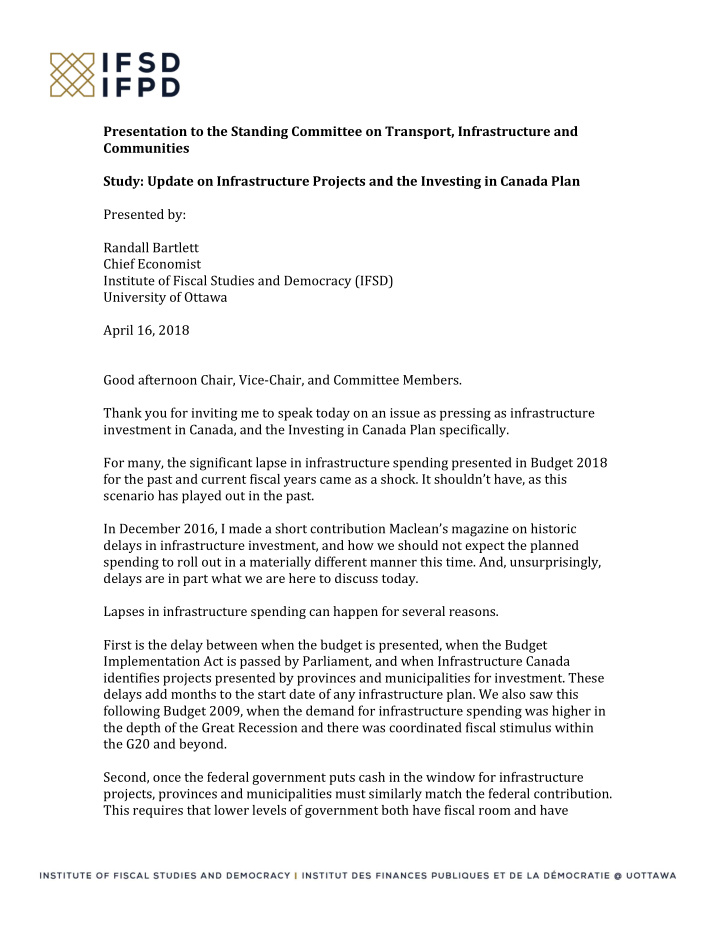



Presentation to the Standing Committee on Transport, Infrastructure and Communities Study: Update on Infrastructure Projects and the Investing in Canada Plan Presented by: Randall Bartlett Chief Economist Institute of Fiscal Studies and Democracy (IFSD) University of Ottawa April 16, 2018 Good afternoon Chair, Vice-Chair, and Committee Members. Thank you for inviting me to speak today on an issue as pressing as infrastructure investment in Canada, and the Investing in Canada Plan specifically. For many, the significant lapse in infrastructure spending presented in Budget 2018 for the past and current fiscal years came as a shock. It shouldn’t have, as this scenario has played out in the past. In December 2016, I made a short contribution Maclean’s magazine on historic delays in infrastructure investment, and how we should not expect the planned spending to roll out in a materially different manner this time. And, unsurprisingly, delays are in part what we are here to discuss today. Lapses in infrastructure spending can happen for several reasons. First is the delay between when the budget is presented, when the Budget Implementation Act is passed by Parliament, and when Infrastructure Canada identifies projects presented by provinces and municipalities for investment. These delays add months to the start date of any infrastructure plan. We also saw this following Budget 2009, when the demand for infrastructure spending was higher in the depth of the Great Recession and there was coordinated fiscal stimulus within the G20 and beyond. Second, once the federal government puts cash in the window for infrastructure projects, provinces and municipalities must similarly match the federal contribution. This requires that lower levels of government both have fiscal room and have
prioritized infrastructure as the desired use for said fiscal room in a manner that will qualify to receive federal funds. Which brings us to the third point – different levels of government may have different infrastructure priorities. At the federal level, we have five priority areas for infrastructure spending – public transit, green, social, trade and transportation, and rural and northern communities. These priorities were first laid out in the 2015 Liberal Party election platform. As such, given the limited resources available to the current government at that time, it may be reasonable to assume that consultations with provinces and municipalities on their priorities were similarly limited. But even if priorities aren’t perfectly aligned, one would assume it shouldn’t be hard to fit a round infrastructure project in a square funding hole if that is an overwhelming desire by multiple levels of government. Which brings us to the fourth reason infrastructure money may be lapsed – need or, more accurately, a lack thereof. Need may be looked at in a few different ways. If infrastructure spending is to be used as short-term economic stimulus, one needs to look to the stage of the business cycle. Currently, to paraphrase the Bank of Canada in the press statement that accompanied its recent interest rate announcement: The Canadian economy is operating near its capacity and has little, if any, labour market slack. As such, there doesn’t not appear to be an overwhelming need for short-term fiscal stimulus. But perhaps there is a long-term infrastructure gap that needs to be addressed. This was argued by the Finance Minister’s Advisory Council on Economic Growth in the fall of 2016, with the estimate of the infrastructure gap ranging from $150 billion to $1 trillion – a wide range by any measure. But the point was clear, the infrastructure gap is large. However, this assertion was contradicted by a report from the McKinsey Global Institute in June 2016. In this report, entitled ‘Bridging Global Infrastructure Gaps’, the McKinsey Global Institute estimated that Canada did not have an infrastructure gap at all, based on historic and planned infrastructure spending and projected future need. Indeed, this conclusion was reconfirmed by the McKinsey Global Institute in a subsequent October 2017 note, entitled ‘Bridging Infrastructure Gaps: Has the World Made Progress?’. This conclusion matters because, unlike the Canadian analyses referenced by the Advisory Council, the McKinsey Global Institute employs the approach which is closest to best practice. And best practice is this: understanding the current stock of infrastructure and its remaining useful life paired with a future needs assessment
based on projections of demographics, economics, environment and climate change, and technological innovation. In Canada, we apply none of these best practices, while in other jurisdictions they tend to apply some but not all. In New Zealand, the cities of Wellington and Auckland have developed advanced data architectures that allow you to look at the remaining useful life of pipes under city streets through the use of an app on your smartphone. Meanwhile, the United Kingdom is the country which is literally ‘writing the book’ on how to do a future needs analysis for infrastructure. In New South Wales, Australia, the public sector is applying analytics to squeeze as much value as possible out of existing brownfield assets while considering new, greenfield investments only as a very last resort. And other jurisdictions are similarly moving forward to better understanding of their infrastructure and future needs. So, where do we go from here? If the federal government wants to support infrastructure investments by other levels of government while maximizing value for taxpayers, it should look to put the right data infrastructure in place to build capacity before putting money for traditional infrastructure in the proverbial window. Otherwise, we may find ourselves once again discussing large infrastructure lapses in the not too distant future. Thank you.
Recommend
More recommend